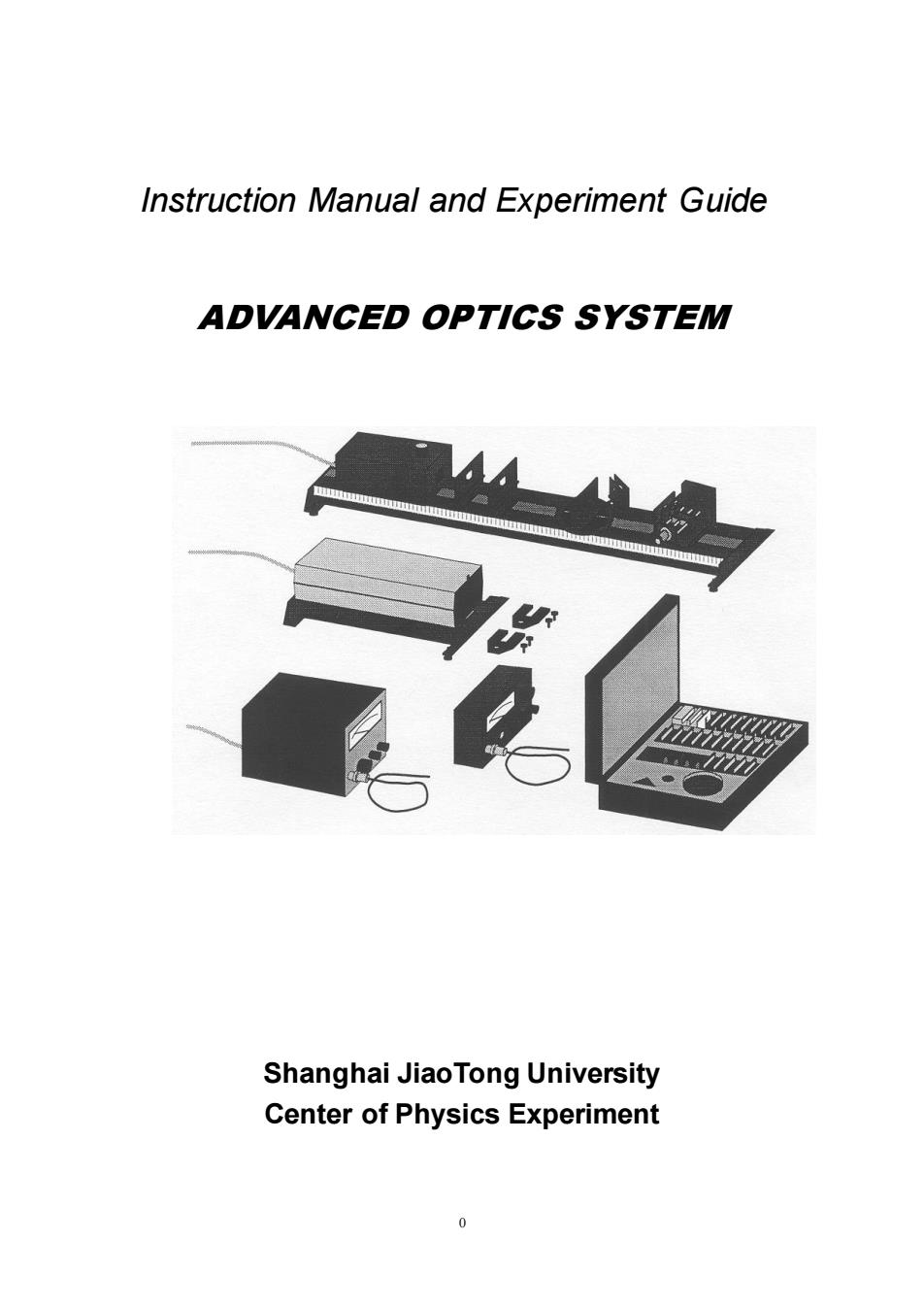
Instruction Manual and Experiment Guide ADVANCED OPTICS SYSTEM Shanghai JiaoTong University Center of Physics Experiment 0
0 Instruction Manual and Experiment Guide ADVANCED OPTICS SYSTEM Shanghai JiaoTong University Center of Physics Experiment

Table of Contents Section Page ntroduction..................................................... .2 Equ1 oment..........…..2 Experiments Experiment 1:Reflection......... 23 Experiment 2:Refraction...... 26 Experiment 3:Lenses...... .30 Experiment4:The Wave Nature ofLight.........................35 Experiment5:The Laser..................37 Experiment 6:Interference From Multiple Reflections..........40 Experiment 7:Diffraction By Slits......................... 41 Experiment 8:Diffraction at Circular Edges......................43 Experiment 9:DeterminingThe WavelengthofLight...........46 Experiment 10:Polarization......... .48 Experiment 11:Optical Activity..... 51 Experiment 12:Scattering...... 53 Experiment 13:Holography............................ .56 1
1 Table of Contents Section Page Introduction…………………………………………….….…………1 Equipment……………………………………………….….………..2 Experiments Experiment 1: Reflection……………………………….…….23 Experiment 2: Refraction………………………………..……26 Experiment 3: Lenses………………………………………….30 Experiment 4: The Wave Nature of Light……….…………….35 Experiment 5: The Laser……………………………………....37 Experiment 6: Interference From Multiple Reflections……….40 Experiment 7: Diffraction By Slits……………………………41 Experiment 8: Diffraction at Circular Edges………………….43 Experiment 9: Determining The Wavelength of Light…….….46 Experiment 10: Polarization…………………………………..48 Experiment 11: Optical Activity………………………………51 Experiment 12: Scattering………………………………….…53 Experiment 13: Holography…………………………………..56
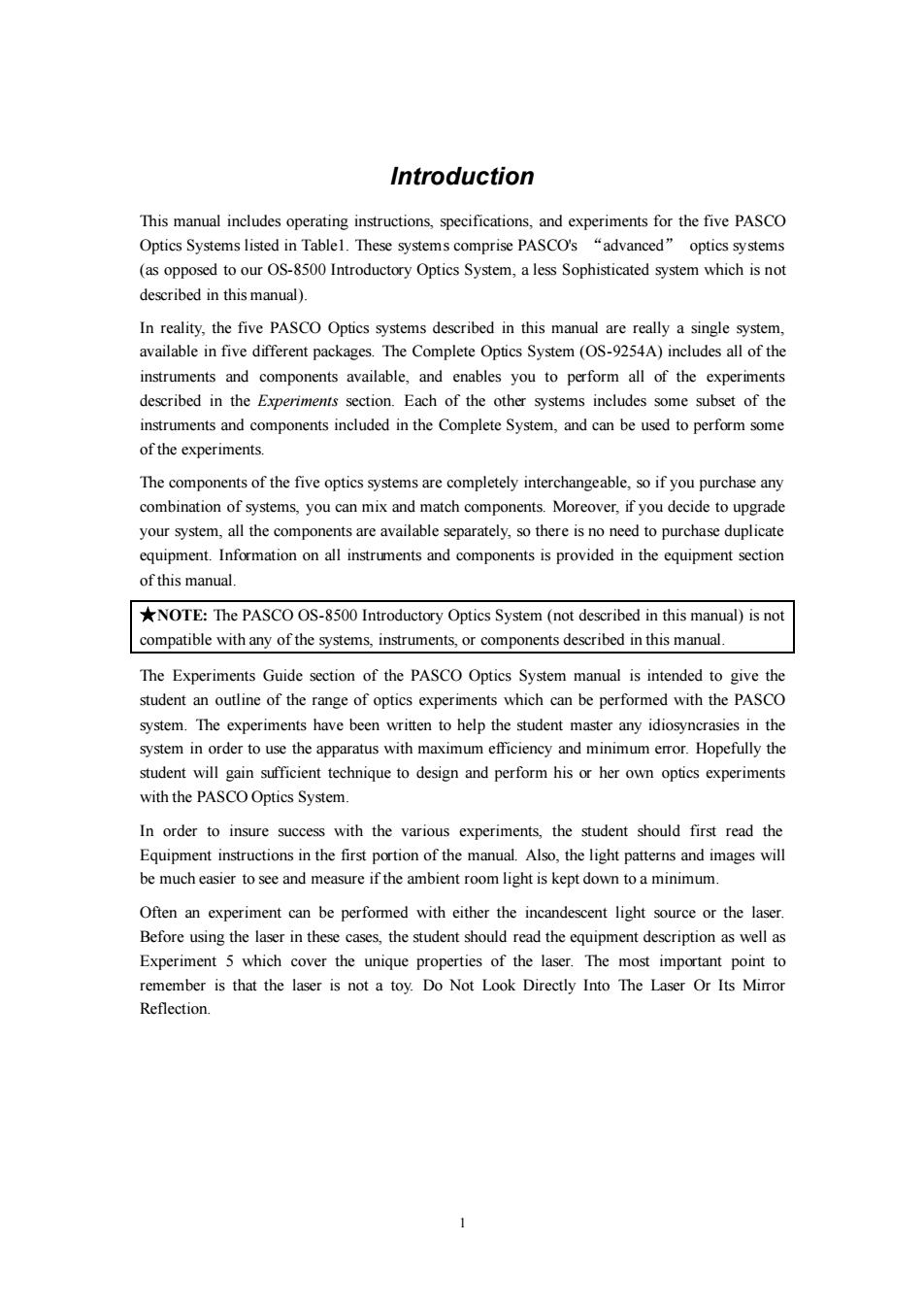
Introduction This manual includes operating instructions,specifications,and experiments for the five PASCO Optics Systems listed in Tablel.These systems comprise PASCO's "advanced"optics systems (as opposed to our OS-8500 Introductory Optics System,a less Sophisticated system which is not described in this manual). In reality,the five PASCO Optics systems described in this manual are really a single system, available in five different packages.The Complete Optics System(OS-9254A)includes all of the instruments and components available,and enables you to perform all of the experiments described in the Experiments section.Each of the other systems includes some subset of the instruments and components included in the Complete System,and can be used to perform some of the experiments. The components of the five optics systems are completely interchangeable,so if you purchase any combination of systems,you can mix and match components.Moreover,if you decide to upgrade your system,all the components are available separately,so there is no need to purchase duplicate equipment.Information on all instruments and components is provided in the equipment section of this manual. *NOTE:The PASCO OS-8500 Introductory Optics System(not described in this manual)is not compatible with any of the systems,instruments,or components described in this manual The Experiments Guide section of the PASCO Optics System manual is intended to give the student an outline of the range of optics experiments which can be performed with the PASCO system.The experiments have been written to help the student master any idiosyncrasies in the system in order to use the apparatus with maximum efficiency and minimum error.Hopefully the student will gain sufficient technique to design and perform his or her own optics experiments with the PASCO Optics System. In order to insure success with the various experiments,the student should first read the Equipment instructions in the first portion of the manual.Also,the light patterns and images will be much easier to see and measure if the ambient room light is kept down to a minimum. Often an experiment can be performed with either the incandescent light source or the laser. Before using the laser in these cases,the student should read the equipment description as well as Experiment 5 which cover the unique properties of the laser.The most important point to remember is that the laser is not a toy.Do Not Look Directly Into The Laser Or Its Mirror Reflection
1 Introduction This manual includes operating instructions, specifications, and experiments for the five PASCO Optics Systems listed in Table1. These systems comprise PASCO's “advanced” optics systems (as opposed to our OS-8500 Introductory Optics System, a less Sophisticated system which is not described in this manual). In reality, the five PASCO Optics systems described in this manual are really a single system, available in five different packages. The Complete Optics System (OS-9254A) includes all of the instruments and components available, and enables you to perform all of the experiments described in the Experiments section. Each of the other systems includes some subset of the instruments and components included in the Complete System, and can be used to perform some of the experiments. The components of the five optics systems are completely interchangeable, so if you purchase any combination of systems, you can mix and match components. Moreover, if you decide to upgrade your system, all the components are available separately, so there is no need to purchase duplicate equipment. Information on all instruments and components is provided in the equipment section of this manual. ★NOTE: The PASCO OS-8500 Introductory Optics System (not described in this manual) is not compatible with any of the systems, instruments, or components described in this manual. The Experiments Guide section of the PASCO Optics System manual is intended to give the student an outline of the range of optics experiments which can be performed with the PASCO system. The experiments have been written to help the student master any idiosyncrasies in the system in order to use the apparatus with maximum efficiency and minimum error. Hopefully the student will gain sufficient technique to design and perform his or her own optics experiments with the PASCO Optics System. In order to insure success with the various experiments, the student should first read the Equipment instructions in the first portion of the manual. Also, the light patterns and images will be much easier to see and measure if the ambient room light is kept down to a minimum. Often an experiment can be performed with either the incandescent light source or the laser. Before using the laser in these cases, the student should read the equipment description as well as Experiment 5 which cover the unique properties of the laser. The most important point to remember is that the laser is not a toy. Do Not Look Directly Into The Laser Or Its Mirror Reflection
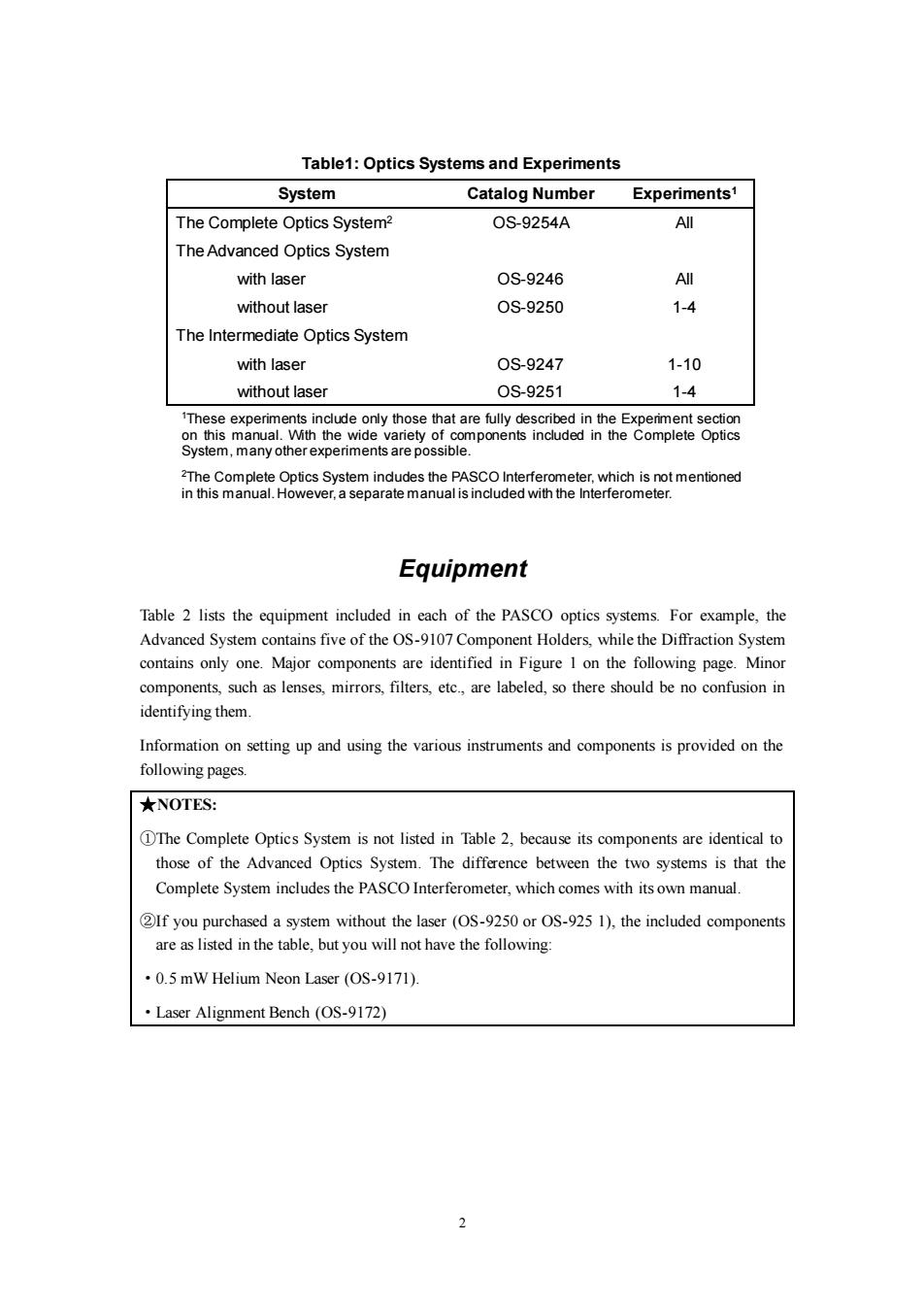
Table1:Optics Systems and Experiments System Catalog Number Experiments1 The Complete Optics System2 0S-9254A All The Advanced Optics System with laser 0S-9246 All without laser 0S-9250 1-4 The Intermediate Optics System with laser 0S9247 1-10 without laser 0S-9251 1-4 1These experiments include only those that are fully described in the Experiment section on this manual.With the wide variety of components included in the Complete Optics System,many other experiments are possible. 2The Complete Optics System indudes the PASCO Interferometer,which is not mentioned in this manual.However,a separate manual is included with the Interferometer. Equipment Table 2 lists the equipment included in each of the PASCO optics systems.For example,the Advanced System contains five of the OS-9107 Component Holders,while the Diffraction System contains only one.Major components are identified in Figure I on the following page.Minor components,such as lenses,mirrors,filters,etc.,are labeled,so there should be no confusion in identifying them. Information on setting up and using the various instruments and components is provided on the following pages. ★NOTES: DThe Complete Optics System is not listed in Table 2,because its components are identical to those of the Advanced Optics System.The difference between the two systems is that the Complete System includes the PASCO Interferometer,which comes with its own manual. 2If you purchased a system without the laser(OS-9250 or OS-925 1),the included components are as listed in the table,but you will not have the following: .0.5 mW Helium Neon Laser (OS-9171). Laser Alignment Bench(OS-9172)
2 Table1: Optics Systems and Experiments System Catalog Number Experiments1 The Complete Optics System2 The Advanced Optics System with laser without laser The Intermediate Optics System with laser without laser OS-9254A OS-9246 OS-9250 OS-9247 OS-9251 All All 1-4 1-10 1-4 1These experiments include only those that are fully described in the Experiment section on this manual. With the wide variety of components included in the Complete Optics System, many other experiments are possible. 2The Complete Optics System includes the PASCO Interferometer, which is not mentioned in this manual. However, a separate manual is included with the Interferometer. Equipment Table 2 lists the equipment included in each of the PASCO optics systems. For example, the Advanced System contains five of the OS-9107 Component Holders, while the Diffraction System contains only one. Major components are identified in Figure 1 on the following page. Minor components, such as lenses, mirrors, filters, etc., are labeled, so there should be no confusion in identifying them. Information on setting up and using the various instruments and components is provided on the following pages. ★NOTES: ①The Complete Optics System is not listed in Table 2, because its components are identical to those of the Advanced Optics System. The difference between the two systems is that the Complete System includes the PASCO Interferometer, which comes with its own manual. ②If you purchased a system without the laser (OS-9250 or OS-925 1), the included components are as listed in the table, but you will not have the following: ·0.5 mW Helium Neon Laser (OS-9171). ·Laser Alignment Bench (OS-9172)

Table2:Component List Catalog Catalog No. Description No. Description 0S-8020 High Sensitivity Photameter 0S-9119 Light Source Apertures(1.0.2.0) 0S-9152B Student Photometer 0S-9120 Diffuser 0S-9171 1 0.5 mW He-NeLaser 0S-9121 Crossed Arrow Target 0S-9257 1 InterferometerSystemwithout Laser 0S-9165 Slits and Patterns(16 sets on 4 slides) 0S-9172 Laser Alignment Bench 0S-9126 Opaque Points and Fresno Zone Plates 0S-9102A Incandescent Light Source 0S-9127 1 1 5276 Line/cm Diffraction Grating 0S-9103 Optics Bench 0S-9128 Glass Plate 0S-9104A Linear Translator 0S-9129 Acrylic Plate OS-9106A Angular Translator/Component Camier 0S-9130 Prism(90) 0S-9107 4 Component Carrier 0S-9131 22 mm F.L.Lens 0S-9108 Glass Dispersion Tank 0S-9132 18mm F.L.Lens 0S-910g Calibrated Polarizer 0S-9133 48 mm F.L.Lens 0S-9110 Calibrated 140 nm Retarder 0S-9134 127mm F.L.Lens 0S-9111 Red Spectral Filter 0S-9135 252mm F.L.Lens 0S-9112 Yellow Spectral Filter 0S-9136 Flat Front Surface Mirror 0S-9113 Green Spectral Filter 0S-9137 1 Concave Front Surface Minor 0S-9114 Blue Spectral Filter 0S-9138 Viewing Screen with Metric Scale 0S-9115 Hologram 0S-9139 Aperture Mask 0S-9116 Photometer Apertures 0S-9140 Fitted Case for Optical Components 0S-9117 Variable Diaphragm 0S-9141 Experiment Manual 0S-9118 Light Source Apertures(0.5.0.75)
3 Table2: Component List Catalog No. Complete Advanced Intermediate Description Catalog No. Complete Advanced Intermediate Description OS-8020 1 1 High Sensitivity Photometer OS-9119 1 1 1 Light Source Apertures (1.0, 2.0) OS-9152B 1 Student Photometer OS-9120 1 1 1 Diffuser OS-9171 1 1 1 0.5 mW He-Ne Laser OS-9121 1 1 1 Crossed Arrow Target OS-9257 1 Interferometer System without Laser OS-9165 1 1 1 Slits and Patterns (16 sets on 4 slides) OS-9172 1 1 1 Laser Alignment Bench OS-9126 1 1 1 Opaque Points and Fresno Zone Plates OS-9102A 1 1 1 Incandescent Light Source OS-9127 1 1 1 5276 Line/cm Diffraction Grating OS-9103 1 1 1 Optics Bench OS-9128 1 1 1 Glass Plate OS-9104A 1 1 1 Linear Translator OS-9129 1 1 1 Acrylic Plate OS-9106A 1 1 1 Angular Translator/Component Carrier OS-9130 1 1 1 Prism (900 ) OS-9107 5 5 4 Component Carrier OS-9131 1 1 1 -22 mm F.L. Lens OS-9108 1 1 Glass Dispersion Tank OS-9132 1 1 1 18 mm F.L. Lens OS-9109 3 3 3 Calibrated Polarizer OS-9133 1 1 1 48 mm F.L. Lens OS-9110 1 1 1 Calibrated 140 nm Retarder OS-9134 1 1 1 127 mm F.L. Lens OS-9111 1 1 Red Spectral Filter OS-9135 1 1 1 252 mm F.L. Lens OS-9112 1 1 Yellow Spectral Filter OS-9136 1 1 1 Flat Front Surface Mirror OS-9113 1 1 Green Spectral Filter OS-9137 1 1 1 Concave Front Surface Mirror OS-9114 1 1 Blue Spectral Filter OS-9138 1 1 1 Viewing Screen with Metric Scale OS-9115 1 1 1 Hologram OS-9139 1 1 1 Aperture Mask OS-9116 1 1 1 Photometer Apertures OS-9140 1 1 1 Fitted Case for Optical Components OS-9117 1 1 1 Variable Diaphragm OS-9141 1 1 1 Experiment Manual OS-9118 1 1 1 Light Source Apertures (0.5, 0.75)

OS-9102B Incandescent Light Source OS-9107 Component OS-9106A Angular Translator with component holder OS-9104B Linear Translator 0S-91710.5mW Helium Neon L OS-9172 Laser gnment Bench (wit Optical Component OS-9152B Stude S-8020 High Sensitivity optio probe er-opnc pre 03-9130P1ism OS-9109 Glass Dispersion Tank Incand ce Figure 1:Advanced Optics Equlpment The Optics Bench Optics Light Source component Bench holder The optics bench(see Figure 2)provides a alignment rail straight,rigid surface for aligning optics experiments.For best results,the bench should be placed on a reasonably flat and level surface,and the leveling screws mmmmmmmmmmm should be adjusted so the bench rests leveling screws and locknuts(4) evenly on all four screws.Once the bench metric scale is leveled,tighten the locknuts so there is Figure 2:Using the Optics Bench no slipping. The incandescent light source and the component holders attach magnetically to the bench as shown.For proper alignment,the edge of the light source and component holders should be mounted flush to the alignment rail,which is the raised edge that runs along one side of the bench.This will ensure that the optical axis of the light source and component holders are coincident,which makes it easier to align optical components
4 The Optics Bench The optics bench (see Figure 2) provides a straight, rigid surface for aligning optics experiments. For best results, the bench should be placed on a reasonably flat and level surface, and the leveling screws should be adjusted so the bench rests evenly on all four screws. Once the bench is leveled, tighten the locknuts so there is no slipping. The incandescent light source and the component holders attach magnetically to the bench as shown. For proper alignment, the edge of the light source and component holders should be mounted flush to the alignment rail, which is the raised edge that runs along one side of the bench. This will ensure that the optical axis of the light source and component holders are coincident, which makes it easier to align optical components

Your optics bench is guaranteed straight to within 0.25 mm over its full one meter length,and, under normal use,will retain its straightness.However the optics bench will bow slightly if heavily loaded.For example,a one-kg mass placed in the center of the bench will produce a deflection of approximately 0.07 mm. NOTE:Avoid scratching or otherwise abusing the surface of the magnetic pads on the top of the optics bench.If they get dirty,use only soapy water or rubbing alcohol for cleaning.Other solvents may dissolve the magnetic surfaces. The Incandescent Light Source The incandescent light source(see Figure 3)provides 1 5 candlepower of light with the frequency spectrum shown in Figure4.The built-in power supply of the light source is regulated,so there's minimal variation in the intensity of the light.This is essential for obtaining accurate data in experiments where a photometer is being used to measure light intensities. ·region fuse over the light a ON witch 10 hmmgmmm 1.000 10.000 100,000 filament knob Wavelength in nanometers Flgure 4:Frequency Spectrum for the Figure 3:Using the Incandescent Light Source NOTE:The distance from the front panel of the light source to the light bulb filament is approximately 22 mm. To turn on the light source,connect the power cord to a grounded receptacle of the appropriate line voltage (120 VAC,60 Hz,unless otherwise specified),and flip the switch on the rear panel to ON.If at any time the light fails to come on,chances are that the fuse is blown or the light bulb is burnt out.See the Maintenance section for replacement instructions. The Filament knob on the top of the light source adjusts the position of the light bulb filament transverse to the optical axis of the bench.The filament moves in the same direction as the knob is turned.Components can be mounted onto the magnetic pad on the front panel of the light source, over the light aperture.The crossed-arrow target,for example,is often mounted in this way as an object for lens experiments. CAUTION:When used continuously,the light source becomes hot to the touch.Since it requires no warm-up time,we recommend it be turned on only when setting up or actually performing an experiment
5 Your optics bench is guaranteed straight to within 0.25 mm over its full one meter length, and, under normal use, will retain its straightness. However the optics bench will bow slightly if heavily loaded. For example, a one-kg mass placed in the center of the bench will produce a deflection of approximately 0.07 mm. ★NOTE: Avoid scratching or otherwise abusing the surface of the magnetic pads on the top of the optics bench. If they get dirty, use only soapy water or rubbing alcohol for cleaning. Other solvents may dissolve the magnetic surfaces. The Incandescent Light Source The incandescent light source (see Figure 3) provides 1 5 candlepower of light with the frequency spectrum shown in Figure4. The built-in power supply of the light source is regulated, so there's minimal variation in the intensity of the light. This is essential for obtaining accurate data in experiments where a photometer is being used to measure light intensities. ★NOTE: The distance from the front panel of the light source to the light bulb filament is approximately 22 mm. To turn on the light source, connect the power cord to a grounded receptacle of the appropriate line voltage (120 VAC, 60 Hz, unless otherwise specified), and flip the switch on the rear panel to ON. If at any time the light fails to come on, chances are that the fuse is blown or the light bulb is burnt out. See the Maintenance section for replacement instructions. The Filament knob on the top of the light source adjusts the position of the light bulb filament transverse to the optical axis of the bench. The filament moves in the same direction as the knob is turned. Components can be mounted onto the magnetic pad on the front panel of the light source, over the light aperture. The crossed-arrow target, for example, is often mounted in this way as an object for lens experiments. ★CAUTION: When used continuously, the light source becomes hot to the touch. Since it requires no warm-up time, we recommend it be turned on only when setting up or actually performing an experiment
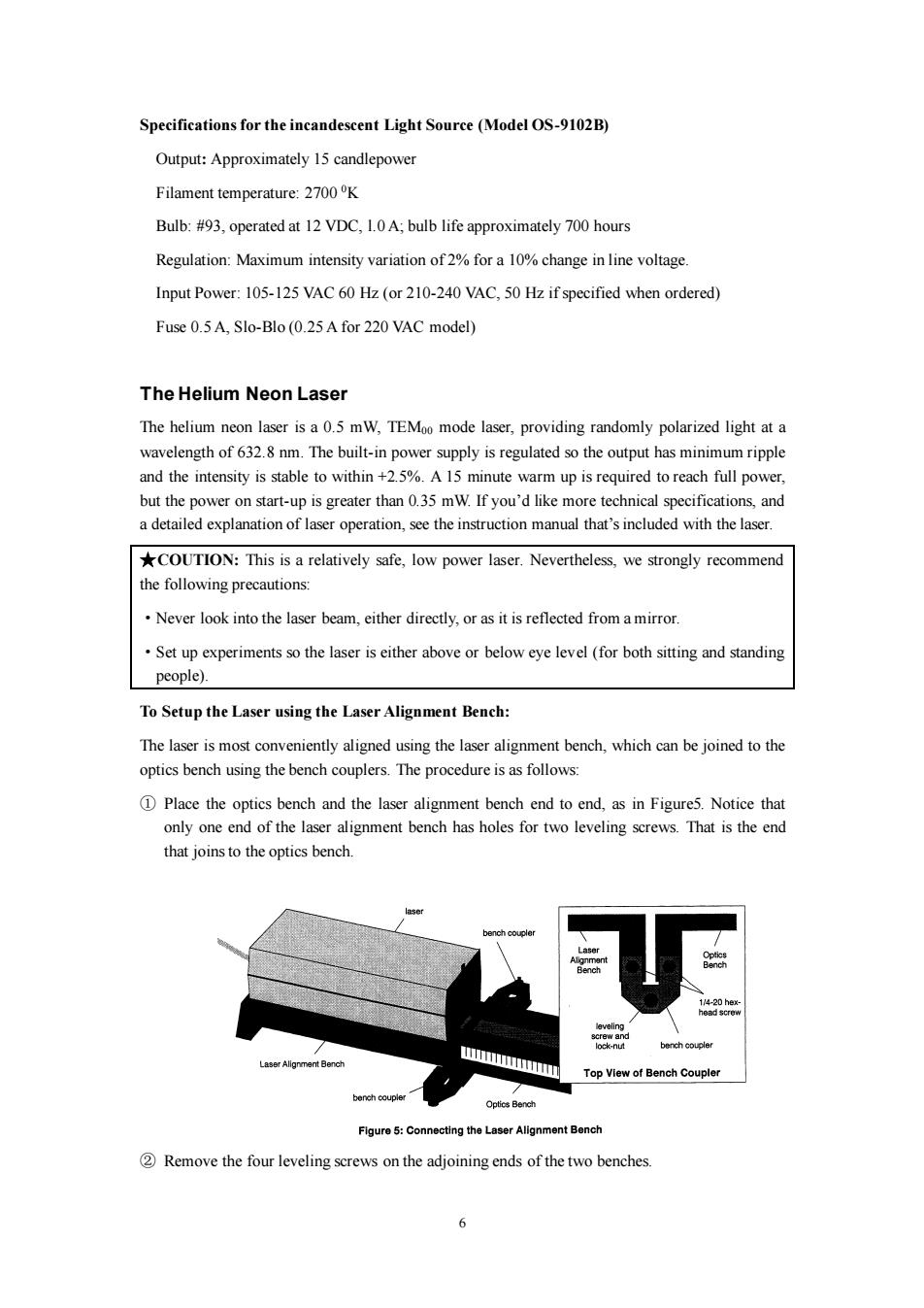
Specifications for the incandescent Light Source(Model OS-9102B) Output:Approximately 15 candlepower Filament temperature:2700K Bulb:#93,operated at 12 VDC,1.0 A;bulb life approximately 700 hours Regulation:Maximum intensity variation of 2%for a 10%change in line voltage. Input Power:105-125 VAC 60 Hz (or 210-240 VAC,50 Hz if specified when ordered) Fuse 0.5A,Slo-Blo (0.25 A for 220 VAC model) The Helium Neon Laser The helium neon laser is a 0.5 mW,TEMoo mode laser,providing randomly polarized light at a wavelength of 632.8 nm.The built-in power supply is regulated so the output has minimum ripple and the intensity is stable to within +2.5%.A 15 minute warm up is required to reach full power, but the power on start-up is greater than 0.35 mW.If you'd like more technical specifications,and a detailed explanation of laser operation,see the instruction manual that's included with the laser. *COUTION:This is a relatively safe,low power laser.Nevertheless,we strongly recommend the following precautions: Never look into the laser beam,either directly,or as it is reflected from a mirror. Set up experiments so the laser is either above or below eye level(for both sitting and standing people). To Setup the Laser using the Laser Alignment Bench: The laser is most conveniently aligned using the laser alignment bench,which can be joined to the optics bench using the bench couplers.The procedure is as follows: 1Place the optics bench and the laser alignment bench end to end,as in Figure5.Notice that only one end of the laser alignment bench has holes for two leveling screws.That is the end that joins to the optics bench. lase bench coupler Laser Alignment Bench 14-20hex ead scrov leveling screw and lock-nut bench coupler Laser Alignment Bench 1111111111171hT Top View of Bench Coupler bench couple Optics Bench Figure 5:Connecting the Laser Alignment Bench 2Remove the four leveling screws on the adjoining ends of the two benches. 6
6 Specifications for the incandescent Light Source (Model OS-9102B) Output: Approximately 15 candlepower Filament temperature: 2700 0K Bulb: #93, operated at 12 VDC, l.0 A; bulb life approximately 700 hours Regulation: Maximum intensity variation of 2% for a 10% change in line voltage. Input Power: 105-125 VAC 60 Hz (or 210-240 VAC, 50 Hz if specified when ordered) Fuse 0.5 A, Slo-Blo (0.25 A for 220 VAC model) The Helium Neon Laser The helium neon laser is a 0.5 mW, TEM00 mode laser, providing randomly polarized light at a wavelength of 632.8 nm. The built-in power supply is regulated so the output has minimum ripple and the intensity is stable to within +2.5%. A 15 minute warm up is required to reach full power, but the power on start-up is greater than 0.35 mW. If you’d like more technical specifications, and a detailed explanation of laser operation, see the instruction manual that’s included with the laser. ★COUTION: This is a relatively safe, low power laser. Nevertheless, we strongly recommend the following precautions: ·Never look into the laser beam, either directly, or as it is reflected from a mirror. ·Set up experiments so the laser is either above or below eye level (for both sitting and standing people). To Setup the Laser using the Laser Alignment Bench: The laser is most conveniently aligned using the laser alignment bench, which can be joined to the optics bench using the bench couplers. The procedure is as follows: ① Place the optics bench and the laser alignment bench end to end, as in Figure5. Notice that only one end of the laser alignment bench has holes for two leveling screws. That is the end that joins to the optics bench. ② Remove the four leveling screws on the adjoining ends of the two benches

3 Use the 1/4-20,hex-head screws that are included with the bench couplers to attach the couplers to the legs of the benches,as shown.Do not yet tighten the screws. 4 Insert one of the leveling screws,rubber foot down,through the threaded hole in each coupler. 5 By adjusting all five leveling screws(one on the laser alignment bench,two on the optics bench,and two on the bench couplers),align the two benches so they are in a straight line.Use a meter stick or a long straight edge on top of the benches to check vertical alignment,and on the side of the bench to check horizontal alignment. 6When the benches are aligned,tighten the locknuts on all the leveling screws,and also tighten the four hex-head screws.After tightening the screws,recheck the alignment. To Align the Laser(so the laser beam is coincident with the optical axis of the bench): 1Place a piece of masking tape or tape a piece of paper over the square hole on the front of a component holder,as in Figure 6.Make a small dot on the tape or paper,in the center of the square hole (1-inch from the top of the component shelf and 1.5-inch from the edge of the component holder). dot 2Place the laser on the alignment bench,as in Figure 5.Center the laser on the bench,and make sure it is reasonably parallel with the bench. 3Place the component holder on the optics bench,about 10 cm from the laser aperture.Make sure that the component holder is flush against the alignment rail of the bench.The dot on the tape now marks the optical axis of the bench. 4 Turn on the laser,and move the aperture end of the laser Flgure 6:Locating sideways,as needed,so that the laser beam falls on the dot. the Optical Axis 5Move the component holder about 90 cm away from the laser aperture.Again,be sure the edge of the component holder is flush against the alignment rail of the bench. 6Without moving the aperture end of the laser,move the rear end of the laser as needed to recent the laser beam on the dot.(You may also need to adjust the leveling screws on the laser alignment bench in order to center the laser beam vertically on the dot.) 7 Repeat steps 3 through 6 until the laser beam is aligned with the dot for both positions of the component holder. The Component Holders Each optics system includes several of the standard component holders that attach magnetically to the optics bench,as in Figure 7.Components mount magnetically onto either side of the component holders.For proper alignment of the components along the optical axis of the bench: DMount the component holder flush against the alignment rail of the bench,as in Figure 7. >
7 ③ Use the 1/4-20, hex-head screws that are included with the bench couplers to attach the couplers to the legs of the benches, as shown. Do not yet tighten the screws. ④ Insert one of the leveling screws, rubber foot down, through the threaded hole in each coupler. ⑤ By adjusting all five leveling screws (one on the laser alignment bench, two on the optics bench, and two on the bench couplers), align the two benches so they are in a straight line. Use a meter stick or a long straight edge on top of the benches to check vertical alignment, and on the side of the bench to check horizontal alignment. ⑥ When the benches are aligned, tighten the locknuts on all the leveling screws, and also tighten the four hex-head screws. After tightening the screws, recheck the alignment. To Align the Laser (so the laser beam is coincident with the optical axis of the bench): ① Place a piece of masking tape or tape a piece of paper over the square hole on the front of a component holder, as in Figure 6. Make a small dot on the tape or paper, in the center of the square hole (1-inch from the top of the component shelf and 1.5-inch from the edge of the component holder). ② Place the laser on the alignment bench, as in Figure 5. Center the laser on the bench, and make sure it is reasonably parallel with the bench. ③ Place the component holder on the optics bench, about 10 cm from the laser aperture. Make sure that the component holder is flush against the alignment rail of the bench. The dot on the tape now marks the optical axis of the bench. ④ Turn on the laser, and move the aperture end of the laser sideways, as needed, so that the laser beam falls on the dot. ⑤ Move the component holder about 90 cm away from the laser aperture. Again, be sure the edge of the component holder is flush against the alignment rail of the bench. ⑥ Without moving the aperture end of the laser, move the rear end of the laser as needed to recent the laser beam on the dot. (You may also need to adjust the leveling screws on the laser alignment bench in order to center the laser beam vertically on the dot.) ⑦ Repeat steps 3 through 6 until the laser beam is aligned with the dot for both positions of the component holder. The Component Holders Each optics system includes several of the standard component holders that attach magnetically to the optics bench, as in Figure 7. Components mount magnetically onto either side of the component holders. For proper alignment of the components along the optical axis of the bench: ①Mount the component holder flush against the alignment rail of the bench, as in Figure 7
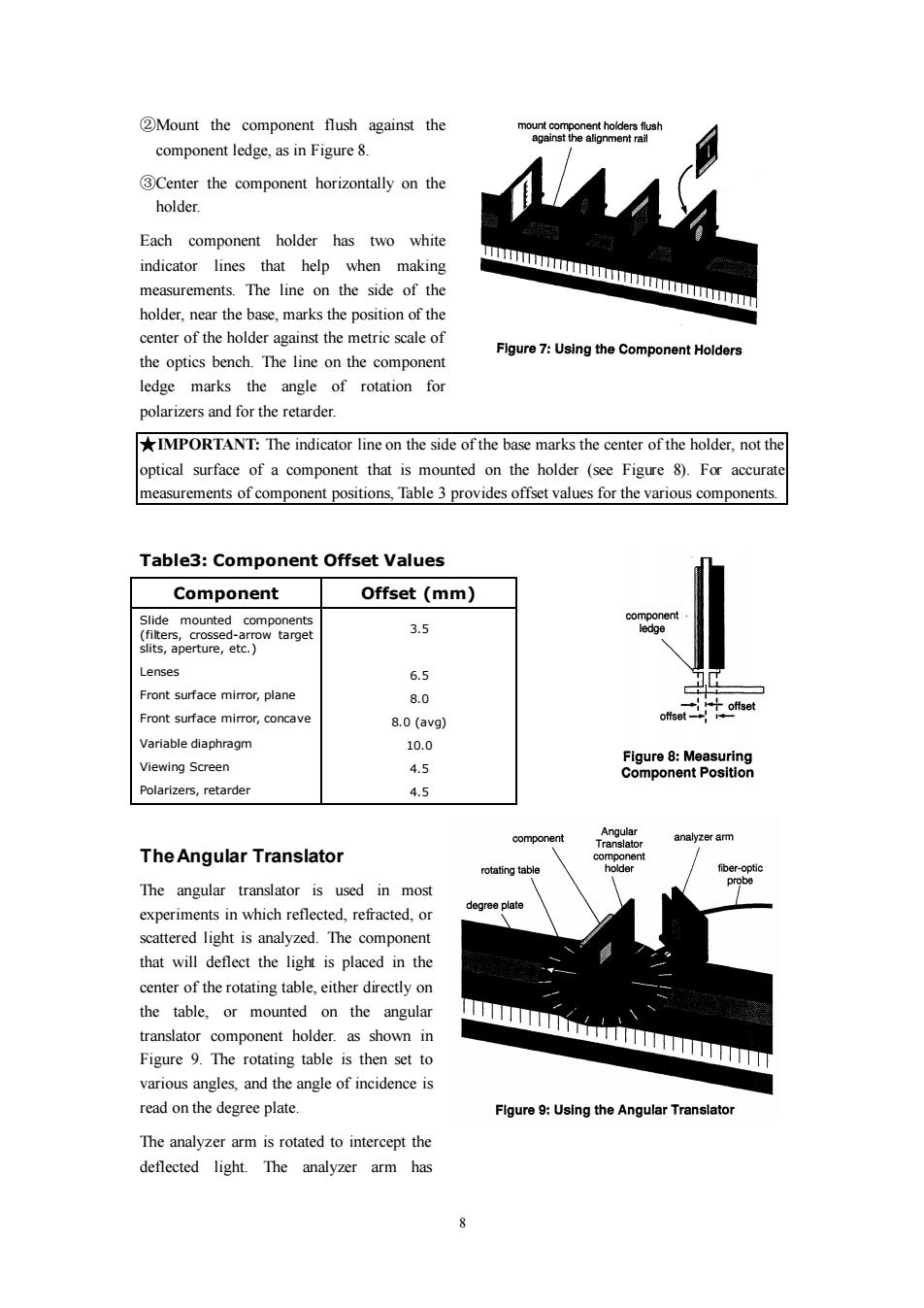
2Mount the component flush against the mount component holders flush against the alignment rail component ledge,as in Figure 8. 3Center the component horizontally on the holder. Each component holder has two white indicator lines that help when making measurements.The line on the side of the mmm holder,near the base,marks the position of the center of the holder against the metric scale of Figure 7:Using the Component Holders the optics bench.The line on the component ledge marks the angle of rotation for polarizers and for the retarder. IMPORTANT:The indicator line on the side of the base marks the center of the holder,not the optical surface of a component that is mounted on the holder (see Figure 8).For accurate measurements of component positions,Table 3 provides offset values for the various components. Table3:Component Offset Values Component Offset(mm) Slide mounted components component (filters,crossed-arrow target 3.5 ledge slits,aperture,etc. Lenses 6.5 Front surface mirror,plane 8.0 offset offset Front surface mirror,concave 8.0(avg) Variable diaphragm 10.0 Figure 8:Measuring Viewing Screen 4.5 Component Position Polarizers,retarder 4.5 Angular component analyzer arm Translator The Angular Translator component rotating table holder f他er-optic The angular translator is used in most probe experiments in which reflected,refracted,or degree plate scattered light is analyzed.The component that will deflect the light is placed in the center of the rotating table,either directly on the table,or mounted on the angular translator component holder.as shown in Figure 9.The rotating table is then set to various angles,and the angle of incidence is read on the degree plate. Flgure 9:Using the Angular Translator The analyzer arm is rotated to intercept the deflected light.The analyzer arm has 8
8 ②Mount the component flush against the component ledge, as in Figure 8. ③Center the component horizontally on the holder. Each component holder has two white indicator lines that help when making measurements. The line on the side of the holder, near the base, marks the position of the center of the holder against the metric scale of the optics bench. The line on the component ledge marks the angle of rotation for polarizers and for the retarder. ★IMPORTANT: The indicator line on the side of the base marks the center of the holder, not the optical surface of a component that is mounted on the holder (see Figure 8). For accurate measurements of component positions, Table 3 provides offset values for the various components. Table3: Component Offset Values Component Offset (mm) Slide mounted components (filters, crossed-arrow target slits, aperture, etc.) Lenses Front surface mirror, plane Front surface mirror, concave Variable diaphragm Viewing Screen Polarizers, retarder 3.5 6.5 8.0 8.0 (avg) 10.0 4.5 4.5 The Angular Translator The angular translator is used in most experiments in which reflected, refracted, or scattered light is analyzed. The component that will deflect the light is placed in the center of the rotating table, either directly on the table, or mounted on the angular translator component holder. as shown in Figure 9. The rotating table is then set to various angles, and the angle of incidence is read on the degree plate. The analyzer arm is rotated to intercept the deflected light. The analyzer arm has